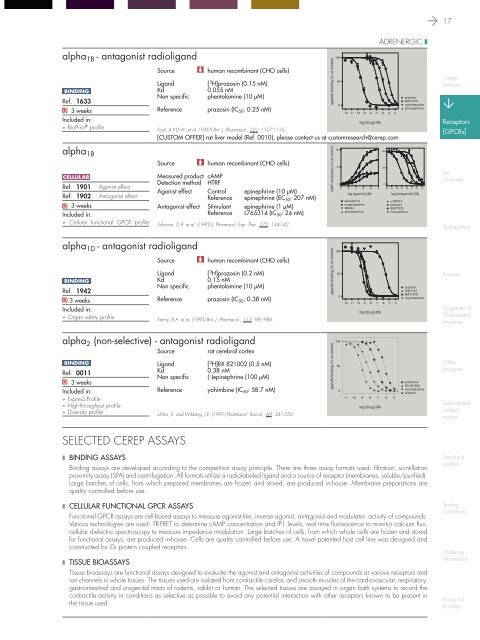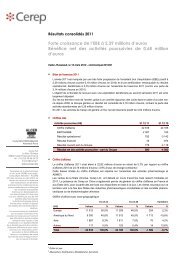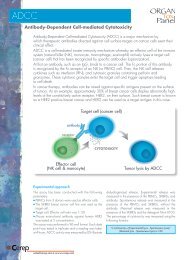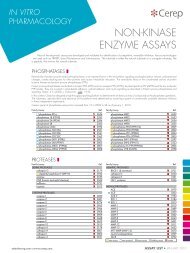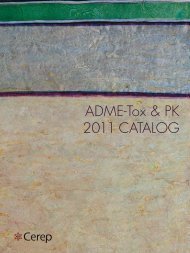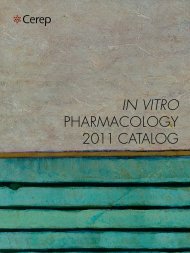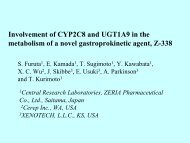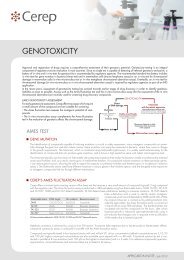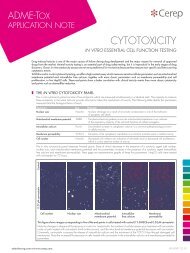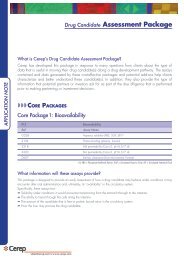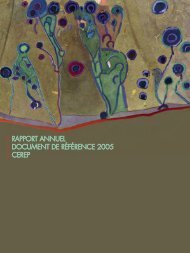in vitro PHARMACOLOGY 2011 CATALOG - Cerep
in vitro PHARMACOLOGY 2011 CATALOG - Cerep
in vitro PHARMACOLOGY 2011 CATALOG - Cerep
You also want an ePaper? Increase the reach of your titles
YUMPU automatically turns print PDFs into web optimized ePapers that Google loves.
17<br />
alpha 1B - antagonist radioligand<br />
b<strong>in</strong>d<strong>in</strong>g<br />
Ref. 1633<br />
Q 3 weeks<br />
Included <strong>in</strong>:<br />
BioPr<strong>in</strong>t ® profile<br />
Source<br />
Ligand<br />
Kd<br />
Non specific<br />
Reference<br />
human recomb<strong>in</strong>ant (CHO cells)<br />
[ 3 H]prazos<strong>in</strong> (0.15 nM)<br />
0.055 nM<br />
phentolam<strong>in</strong>e (10 µM)<br />
prazos<strong>in</strong> (IC 50 : 0.25 nM)<br />
specific b<strong>in</strong>d<strong>in</strong>g (% of control)<br />
100<br />
50<br />
0<br />
-12<br />
-11 -10 -9 -8 -7 -6 -5 -4<br />
log [drug] (M)<br />
Ford, A.P.D.W. et al. (1997) Brit. J. Pharmacol., 121: 1127-1135.<br />
[CUSTOM OFFER] rat liver model (Ref. 0010), please contact us at customresearch@cerep.com<br />
adrenergic ❚<br />
prazos<strong>in</strong><br />
BMY7378<br />
oxymetazol<strong>in</strong>e<br />
phenylephr<strong>in</strong>e<br />
<strong>Cerep</strong><br />
services<br />
<br />
Receptors<br />
[GPCRs]<br />
alpha 1B<br />
cellul ar<br />
Ref. 1901<br />
Ref. 1902<br />
Q 3 weeks<br />
Included <strong>in</strong>:<br />
Agonist effect<br />
Antagonist effect<br />
Cellular functional GPCR profile<br />
Source<br />
human recomb<strong>in</strong>ant (CHO cells)<br />
Measured product cAMP<br />
Detection method HTRF<br />
Agonist effect Control ep<strong>in</strong>ephr<strong>in</strong>e (10 µM)<br />
Reference ep<strong>in</strong>ephr<strong>in</strong>e (EC 50 : 207 nM)<br />
Antagonist effect Stimulant ep<strong>in</strong>ephr<strong>in</strong>e (1 µM)<br />
Reference L765314 (IC 50 : 24 nM)<br />
Schw<strong>in</strong>n, D.A. et al. (1995) J. Pharmacol. Exp. Ther., 272: 134-142.<br />
cAMP modulation (% of control)<br />
100<br />
100<br />
50<br />
50<br />
0<br />
0<br />
-9 -8 -7 -6 -5 -4 -12 -11 -10 -9 -8 -7 -6 -5<br />
log [agonist] (M)<br />
log [antagonist] (M)<br />
ep<strong>in</strong>ephr<strong>in</strong>e<br />
L765314<br />
norep<strong>in</strong>ephr<strong>in</strong>e<br />
prazos<strong>in</strong><br />
M6434<br />
BMY7378<br />
phenylephr<strong>in</strong>e<br />
corynanth<strong>in</strong>e<br />
Ion<br />
channels<br />
Transporters<br />
alpha 1D - antagonist radioligand<br />
Source<br />
human recomb<strong>in</strong>ant (CHO cells)<br />
Ligand<br />
[ 3 H]prazos<strong>in</strong> (0.2 nM)<br />
b<strong>in</strong>d<strong>in</strong>g<br />
Kd<br />
0.15 nM<br />
Ref. 1942<br />
Non specific phentolam<strong>in</strong>e (10 µM)<br />
Q 3 weeks<br />
Reference prazos<strong>in</strong> (IC 50 : 0.38 nM)<br />
Included <strong>in</strong>:<br />
Organ safety profile<br />
Kenny, B.A. et al. (1995) Brit. J. Pharmacol., 115: 981-986.<br />
specific b<strong>in</strong>d<strong>in</strong>g (% of control)<br />
100<br />
50<br />
0<br />
-12 -11 -10 -9 -8 -7 -6 -5 -4<br />
log [drug] (M)<br />
prazos<strong>in</strong><br />
WB 4101<br />
BMY7378<br />
oxymetazol<strong>in</strong>e<br />
K<strong>in</strong>ases<br />
Epigenetic &<br />
DNA-related<br />
enzymes<br />
alpha 2 (non-selective) - antagonist radioligand<br />
b<strong>in</strong>d<strong>in</strong>g<br />
Ref. 0011<br />
Q 3 weeks<br />
Included <strong>in</strong>:<br />
ExpresS Profile<br />
High-throughput profile<br />
Diversity profile<br />
Source<br />
Ligand<br />
Kd<br />
Non specific<br />
Reference<br />
rat cerebral cortex<br />
[ 3 H]RX 821002 (0.5 nM)<br />
0.38 nM<br />
(-)ep<strong>in</strong>ephr<strong>in</strong>e (100 µM)<br />
yohimb<strong>in</strong>e (IC 50 : 58.7 nM)<br />
Uhlen, S. and Wikberg, J.E. (1991) Pharmacol. Toxicol., 69: 341-350.<br />
specific b<strong>in</strong>d<strong>in</strong>g (% of control)<br />
100<br />
50<br />
0<br />
-11 -10 -9 -8 -7 -6 -5<br />
log [drug] (M)<br />
yohimb<strong>in</strong>e<br />
RX 821002<br />
oxymetazol<strong>in</strong>e<br />
prazos<strong>in</strong><br />
Other<br />
enzymes<br />
Specialized<br />
cellular<br />
assays<br />
selected cerep assays<br />
❚ b<strong>in</strong>d<strong>in</strong>g assays<br />
B<strong>in</strong>d<strong>in</strong>g assays are developed accord<strong>in</strong>g to the competition assay pr<strong>in</strong>ciple. There are three assay formats used: filtration, sc<strong>in</strong>tillation<br />
proximity assay (SPA) and centrifugation. All formats utilize a radiolabeled ligand and a source of receptor (membranes, soluble/purified).<br />
Large batches of cells, from which prepared membranes are frozen and stored, are produced <strong>in</strong>-house. Membrane preparations are<br />
quality controlled before use.<br />
❚ cellular Functional GPCR assays<br />
Functional GPCR assays are cell-based assays to measure agonist-like, <strong>in</strong>verse agonist, antagonist and modulator activity of compounds.<br />
Various technologies are used: TR-FRET to determ<strong>in</strong>e cAMP concentration and IP1 levels, real time fluorescence to monitor calcium flux,<br />
cellular dielectric spectroscopy to measure impedance modulation. Large batches of cells, from which whole cells are frozen and stored<br />
for functional assays, are produced <strong>in</strong>-house. Cells are quality controlled before use. A novel patented host cell l<strong>in</strong>e was designed and<br />
constructed for Gi prote<strong>in</strong> coupled receptors.<br />
❚ tissue bioassays<br />
Tissue bioassays are functional assays designed to evaluate the agonist and antagonist activities of compounds at various receptors and<br />
ion channels <strong>in</strong> whole tissues. The tissues used are isolated from contractile cardiac and smooth muscles of the cardiovascular, respiratory,<br />
gastro<strong>in</strong>test<strong>in</strong>al and urogenital tracts of rodents, rabbit or human. The selected tissues are assayed <strong>in</strong> organ bath systems to record the<br />
contractile activity <strong>in</strong> conditions as selective as possible to avoid any potential <strong>in</strong>teraction with other receptors known to be present <strong>in</strong><br />
the tissue used.<br />
Standard<br />
profiles<br />
Test<strong>in</strong>g<br />
conditions<br />
Order<strong>in</strong>g<br />
<strong>in</strong>formation<br />
Assay list<br />
& <strong>in</strong>dex


